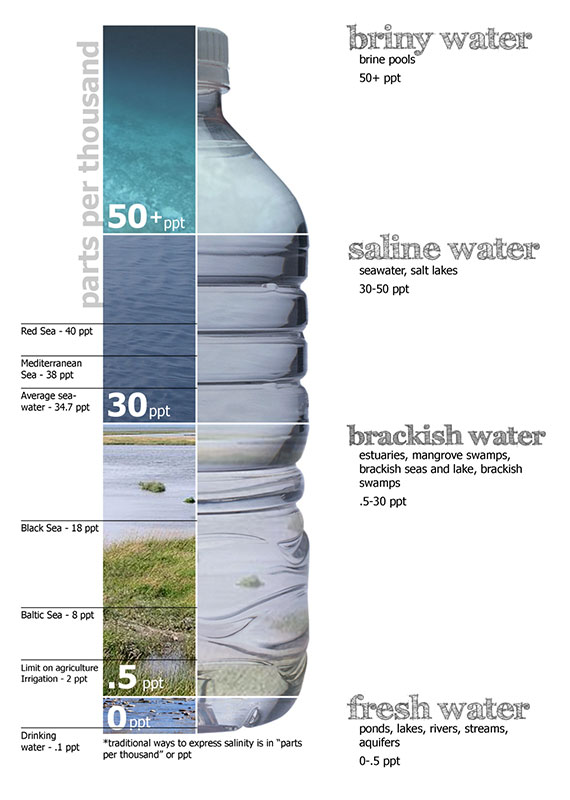Sea water contains dissolved salts of different nature, the quantity of which varies according to the places, seasons and the surrounding environment.
On average, seawater has the following characteristics:
- pH between 7.6 and 8.4
- density at 20 ° C of about 1025 kg / m3
- conductivity at 20 ° C between 48000 and 60000 μS / cm
- TDS5 salinity between 34000 and 45000 ppm
- dissolved air between 20 and 28 ppm
Conductivity and salinity are closely linked: the former is often used as an index of salinity as it is more easily measurable. The pH instead depends on the quantity of dissolved CO2.
Salinity is the most important parameter as it reports the total quantity of dissolved salts (sodium chloride, magnesium, calcium sulphates and bicarbonates). The highest accuracy is obtained by using the parts per million (ppm) as the unit of measurement, other units of measurement are also popular, including «grams on kg» or the percentage on the total mass.
Among the main dissolved elements, calcium (C), always present in large quantities in ionic form, represents a rather critical element because during desalination processes it can concentrate up to precipitate and thus produce incrustations. Calcium in the presence of carbonate ions forms calcium carbonate (CaCO3) which, slightly soluble in water, tends to precipitate, while in the presence of sulphate ions it produces calcium sulphate (CaSO4) which is also slightly soluble. To avoid the formation of these compounds, it is good practice not to concentrate the brine beyond the precipitation limit, thus also safeguarding the correct operation of the plant.
Recent studies on water magnetism have shown that super magnets produced with rare earths contribute significantly to eliminating calcium sedimentation by acting on its intrinsic nature.
The presence of boron in the water affects its potability as the WHO has set the limit below 0.5 ppm. The problematic nature of this element occurs in reverse osmosis systems because the particles are small enough to pass through the membrane and concentrate in the permeate.
The sea is the largest carbon dioxide receptor in the air, in fact the CO2 dissolves particularly well in the water. Its presence, interacting with bicarbonates, can cause problems in the reverse osmosis process as its molecules, passing through the membrane, concentrate in the permeate with a consequent increase in acidity.
Other elements and compounds to which you need to pay attention are oils and hydrocarbons that can create inconveniences such as the generation of foams during thermal processes or, in reverse osmosis, adhere to the membranes causing their occlusion. Finally, the presence of ammonia if it exceeds certain concentrations represents a threat of chemical corrosion for copper and its alloys, widely used in thermal processes.
The water is divided into four types according to the quantity of dissolved salts:
- Fresh water up to 450 ppm
- Brackish water from 500 to 30,000 ppm
- Marine water from 30.001 to 50.000 ppm
- Brine over 50,000 ppm











